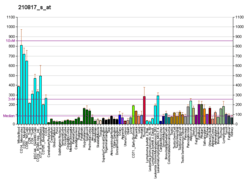Calcium-binding and coiled-coil domain-containing protein 2 is a protein that in humans is encoded by the CALCOCO2 gene.[3][4]
The protein encoded by this gene is a subunit of nuclear domain 10 (ND10) bodies. ND10 bodies are nuclear domains appearing immunohistochemically as ten dots per nucleus. They are believed to be associated with the nuclear matrix on the basis of their resistance to nuclease digestion and salt extraction. ND10 proteins are removed from the nucleus by HSV-1 infection and may have a role in viral life cycles.[4]
Further reading
- Maruyama K, Sugano S (1994). "Oligo-capping: a simple method to replace the cap structure of eukaryotic mRNAs with oligoribonucleotides". Gene. 138 (1–2): 171–4. doi:10.1016/0378-1119(94)90802-8. PMID 8125298.
- Sternsdorf T, Jensen K, Züchner D, Will H (1997). "Cellular localization, expression, and structure of the nuclear dot protein 52". J. Cell Biol. 138 (2): 435–48. doi:10.1083/jcb.138.2.435. PMC 2138200. PMID 9230084.
- Suzuki Y, Yoshitomo-Nakagawa K, Maruyama K, et al. (1997). "Construction and characterization of a full length-enriched and a 5'-end-enriched cDNA library". Gene. 200 (1–2): 149–56. doi:10.1016/S0378-1119(97)00411-3. PMID 9373149.
- Florin L, Schäfer F, Sotlar K, et al. (2002). "Reorganization of nuclear domain 10 induced by papillomavirus capsid protein l2". Virology. 295 (1): 97–107. doi:10.1006/viro.2002.1360. PMID 12033769.
- Strausberg RL, Feingold EA, Grouse LH, et al. (2003). "Generation and initial analysis of more than 15,000 full-length human and mouse cDNA sequences". Proc. Natl. Acad. Sci. U.S.A. 99 (26): 16899–903. doi:10.1073/pnas.242603899. PMC 139241. PMID 12477932.
- Di Y, Li J, Zhang Y, et al. (2004). "HCC-associated protein HCAP1, a variant of GEMIN4, interacts with zinc-finger proteins". J. Biochem. 133 (6): 713–8. doi:10.1093/jb/mvg091. PMID 12869526.
- Everett RD, Sourvinos G, Leiper C, et al. (2004). "Formation of nuclear foci of the herpes simplex virus type 1 regulatory protein ICP4 at early times of infection: localization, dynamics, recruitment of ICP27, and evidence for the de novo induction of ND10-like complexes". J. Virol. 78 (4): 1903–17. doi:10.1128/JVI.78.4.1903-1917.2004. PMC 369473. PMID 14747555.
- Colland F, Jacq X, Trouplin V, et al. (2004). "Functional proteomics mapping of a human signaling pathway". Genome Res. 14 (7): 1324–32. doi:10.1101/gr.2334104. PMC 442148. PMID 15231748.
- Rual JF, Venkatesan K, Hao T, et al. (2005). "Towards a proteome-scale map of the human protein-protein interaction network". Nature. 437 (7062): 1173–8. doi:10.1038/nature04209. PMID 16189514.
- Morriswood B, Ryzhakov G, Puri C, et al. (2007). "T6BP and NDP52 are myosin VI binding partners with potential roles in cytokine signalling and cell adhesion". J. Cell Sci. 120 (Pt 15): 2574–85. doi:10.1242/jcs.007005. PMC 2621013. PMID 17635994.


